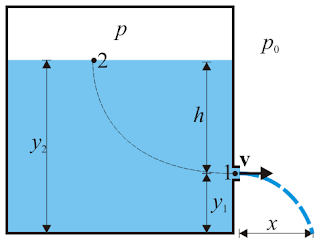SPEED OF EFFLUX

Going further in the Article , we have to understand the meaning of efflux first.
Then , what is efflux?
If we talk about the efflux then efflux is nothing , but it is a simple flowing of fluid just like a jet from a very tiny hole ie. Orifice , and it is necessary that the cross sectional area of the orifice is very small as compared to the cross sectional area of the tank.
Many of us must have seen , the flowing of fluid through a hole of a tank like as a jet , and we have seen that this flowing fluid falls to the ground at some distance from the base o the tank. This distance from the base of the tank is called range of fluid jet.
Now we are going to talk about the Torricelli law.
TORRICELLI LAW
If we talk about the Torricelli law then Torricelli law only tells us about the speed of efflux. And says that if a tank is filled with the fluid to the height h , above the orifice, then the speed of efflux is equal to the speed of free fall of a drop of fluid from the free surface of the fluid to the orifice.
This velocity of efflux can be find by equating the kinetic energy gained to the potential energy lost during free fall of drop of fluid.
Now we are going to deriving the formula for speed of efflux.
DERIVATION
Let’s take a tank , in which fluid is filled to the height Y and the height of the orifice from the base of the tank is y.
Then the height of the fluid above the orifice is h = Y – y
And the elements at the free surface of fluid of the tank is , A2, v2 , p2 , and at the orifice is , A1 , v1 , p1, and ρ is the density of the fluid.
If tank is open at the top then p2 = p(atm) and p1 = p(atm) because orifice is always open to the atmosphere.
Then applying equation of continuity , we get;
A1v1 = A2v2
v2 = A1v1/A2.
Here A1v1 is small because orifice is very small , and A2 is large then on solving we get v2 is very very small and seems us negligible , so we take v2 as zero.
Now applying the concept of Bernoulli principle;
p1 + ρgy + (1/2)ρv1^2 = p2 + ρgY
Here (1/2)ρv2^2 is zero because v2 seems us zero.
So then,
(1/2)ρv1^2 = p2 – p1 + ρg(Y -y)
And we know that, Y – y = h
So, (1/2)ρv1^2 = (p2 -p1) + ρgh
v1^2 = 2gh + 2(p2 – p1)/ρ
Then velocity of efflux is :
v1 = √(2gh + 2(p2 – p1)/ρ. [ p1 = p(atm)
This formula is applicable when tank is closed.
If tank is open then p2 became p(atm).
And formula became:
v1 = √2gh. [ p2-p1 = 0 , because both are atmospheric pressure.]
In kinematics this formula is the velocity of free falling objects.
RANGE OF FLUID JET
If fluid is flowing like a jet then it must be some horizontal distance, that is called range.
Then this range can be simply calculated by multiplying the velocity of efflux and time taken by it to striking the ground. If y is the height of orifice and Y is the height of fluid column, then-
Then time taken by it to coming the ground is given as:
Applying second equation of motion, we get.
y = ut + (1/2)gt^2
y = (1/2)gt^2. [ ut = 0 ]
Then ,. t = √2y/g
Then range R = v1×t = √2gh×√y/g
R = √4yh = 2√yh
Then maximum range is given as follows:
R = 2√yh = 2√y(Y – y)
Differentiate Range wrt to y , we get;
R'(y) = 2 [1/{2√y(Y – y)} ×(Y-2y)]
Equating R'(y) equal to 0
(Y -2y)/√y(Y-y) = 0
We get ,. Y – 2y =0
Then double differentiation of Y-2y wrt to y , then we get (-2) which is less than 0 , so it is Maxima.
Y = 2y , y = Y/2 is point of Maxima.
Putting value of y= Y/2 in the formula of range, then we get,
R = 2√Y(Y -(Y/2))/2
R = 2√Y^2/4 = Y
It means it’s maximum range is equal to the height of the fluid column in the tank .
Phenomenal